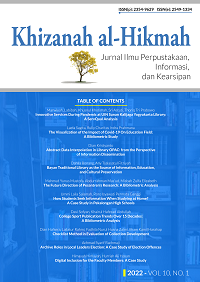Innovative Services During Pandemic at UIN Sunan Kalijaga Yogyakarta Library: A ServQual Analysis
Abstract
Academic library contributes much to the realization of the three pillars of higher education, which are education, research, and social services. During pandemic, university library has to keep contributing to the development of education even when learning-teaching activities are virtually conducted. This research is aimed at identifying sorts of service developed by UIN Sunan Kalijaga Yogyakarta library during the pandemic and at exploring the users’ responses to them by using ServQual approach to evaluate three aspects of innovative services, namely the services being developed, the service supporting facility, and the human resources. This research uses a qualitative method. The data were collected through interviews with 17 qualified informants and documentation. The study showed that the library has made some innovative services to satisfy the users’ needs, particularly the students who were doing their last assignments. The users have benefited much from the innovative services and declared their satisfaction. In term of facility, the library is completed with facilities and infrastructure that are in line with the health protocols. The library also used social media, like WhatsApp and Instagram, to support its services. In addition, the librarians have significantly helped the users access the services.
Downloads
References
Abdi, A. P. (2020, April 12). Nasib Mahasiswa Tingkat Akhir Saat Pandemi Corona COVID-19. tirto.id. https://tirto.id/nasib-mahasiswa-tingkat-akhir-saat-pandemi-corona-covid-19-eMvn
Agava, S. L., & Underwood, P. G. (2020). ICT proficiency: Perspectives of Tangaza University College librarians in Kenya. Library Management, 41(6/7), 487–501. https://doi.org/10.1108/LM-03-2020-0057
Alam, Md. J., & Mezbah-ul-Islam, M. (2020). Service quality assessment model for academic libraries. Global Knowledge, Memory and Communication, 70(4/5), 325–338. https://doi.org/10.1108/GKMC-03-2020-0027
Arshad, A., & Ameen, K. (2011). Reality versus Expectations: A Survey of University of the Punjab’s Libraries Using SERVQUAL. Library Philosophy and Practice (e-Journal), 539, 1–13.
Bopp, R. E., & Smith, L. C. (2001). Reference and information services: An introduction. Libraries Unlimited.
Coyne, P. (2010). Loosely joined: The discovery and consumption of scholarly content in the digital era. In S. McKnight (Ed.), Envisioning future academic library services Initiatives (pp. 101–118). Facet Publishing.
Crawford, J. (2003). Evaluation of Library and Information Services. Routledge.
Denzin, N. K., & Lincoln, Y. S. (2000). Handbook of Qualitative Research. Sage.
Evans, G. E., & Greenwell, S. (2018). Academic Librarianship, Second Edition. American Library Association.
Fagerberg, J., Mowery, P. of B. and P. P. in the W. a H. S. of B. D. C., Mowery, D. C., Nelson, R. R., & Nelson, P. of I. and P. A. R. R. (2005). The Oxford Handbook of Innovation. Oxford University Press.
Fleischman, G. M., Johnson, E. N., & Walker, K. B. (2017). An Exploratory Investigation of Management Accounting Service Quality Dimensions Using Servqual and Servperf. In Advances in Management Accounting (Vol. 29, pp. 91–125). Emerald Publishing Limited. https://doi.org/10.1108/S1474-787120170000029001
Griadhi, M. H. W. (2018). An Evaluation on Library Services Using Servqual Method. SHS Web of Conferences, 42, 00071. https://doi.org/10.1051/shsconf/20184200071
Hartono. (2016). Manajemen Perpustakaan Sekolah. Ar-Ruzz Media.
Hussain, A. (2019). Industrial revolution 4.0: Implication to libraries and librarians. Library Hi Tech News, 37(1), 1–5. https://doi.org/10.1108/LHTN-05-2019-0033
Jan, S. U., Anwar, M. A., & Warraich, N. F. (2016). Library anxiety, library use and academic performance of undergraduate students in Pakistan. Library Review, 65(8/9), 564–577. https://doi.org/10.1108/LR-03-2016-0024
Jana, A., & Rout, R. (2021). Preparedness of the Libraries to Address the Recent Pandemic A Case Study on 100 Top Academic Institutes of India. DESIDOC Journal of Library & Information Technology, 41(03), 175–183. https://doi.org/10.14429/djlit.41.03.16466
Lee, P.-C. (2020). Technological innovation in libraries. Library Hi Tech, 39(2), 574–601. https://doi.org/10.1108/LHT-07-2020-0163
Munde, G., & Marks, K. (2009). Surviving the Future: Academic Libraries, Quality and Assessment. Elsevier.
Neal, J. G., & Jaggars, D. E. (2010). Web 2.0: Redefining & Extending the Academic Library Service Imperative. In S. McKnight (Ed.), Envisioning future academic library services Initiatives, ideas and challenges. Facet Publishing. https://kb.osu.edu/handle/1811/90879
Oyieke, L. I., & Dick, A. L. (2017). Empowering academic librarians for effective e-services: An assessment of Web 2.0 competency levels. The Electronic Library, 35(2), 263–282. https://doi.org/10.1108/EL-10-2015-0200
Perpustakaan UIN Sunan Kalijaga. (2020). Pengumuman. Perpustakaan UIN Sunan Kalijaga. http://lib.uin-suka.ac.id/category/pengumuman/
Pinter, F. (2010). Some new Business ideas in the HSS publishing space: What librarians expext? In S. McKnight (Ed.), Envisioning future academic library services Initiatives, ideas and challenges (pp. 87–100). Facet Publishing.
Scupola, A., & Nicolajsen, H. (2010). Service innovation in academic libraries: Is there a place for the customers? Library Management, 31(4/5), 304–318. https://doi.org/10.1108/01435121011046362
Tobias, C., & Blair, A. (2015). Listen to What You Cannot Hear, Observe What You Cannot See: An Introduction to Evidence-Based Methods for Evaluating and Enhancing the User Experience in Distance Library Services. Journal of Library & Information Services in Distance Learning, 9(1–2). https://doi.org/10.1080/1533290X.2014.946354
UNESCO. (2020, March 4). Education: From disruption to recovery. UNESCO. https://en.unesco.org/covid19/educationresponse
Walton, G., & Webb, P. (2016). Leading the Innovative and Creative Library Workforce: Approaches and Challenges. In Innovation in Libraries and Information Services (Vol. 35, pp. 257–275). Emerald Group Publishing Limited. https://doi.org/10.1108/S0732-067120160000035018
Yusup, P. M. (2010). Pedoman Penyelenggaraan Perpustakaan Sekolah. Kencana Prenada Media.
By submitting your manuscript to our journal, you are following Copyright and License

